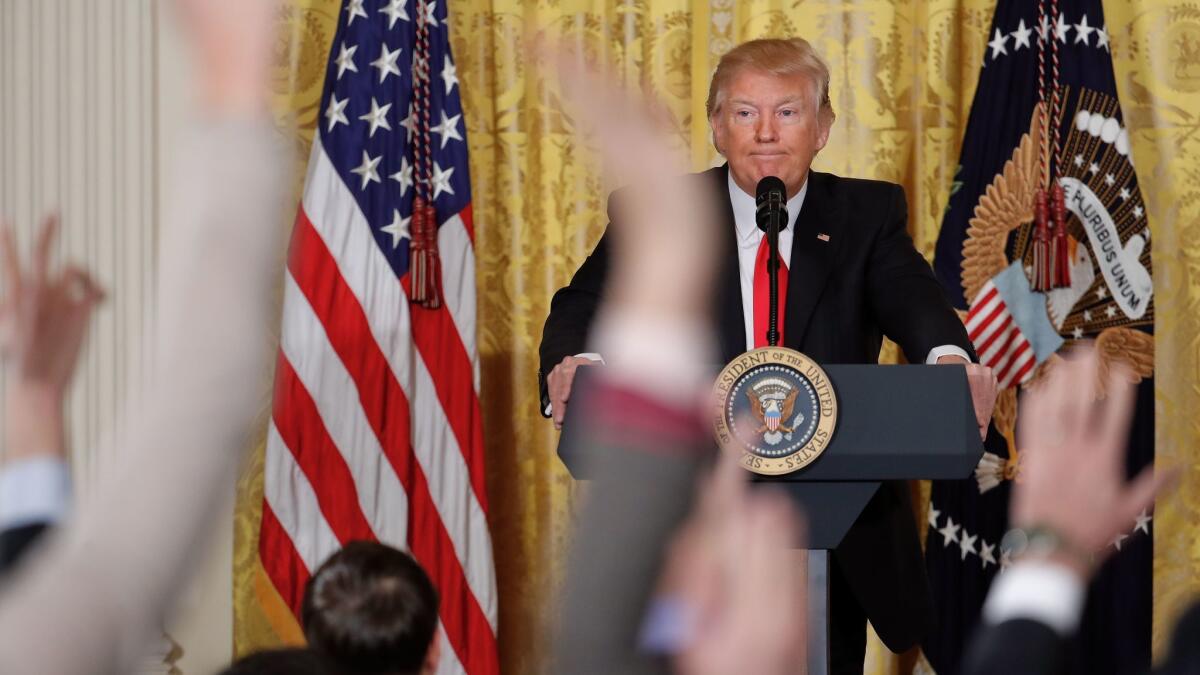Op-Ed: Which is worse, Trump’s anti-media rhetoric, or his prosecution of 2 journalists?

- Share via
From CNN to the New York Times to the Washington Post to this newspaper, pundits and columnists have understandably expressed concern over President Trump’s constant threats against the media. In the months since his inauguration, Trump has implied violence against CNN by sharing a .gif of him “body slamming” the CNN logo, asked the FBI to investigate reporters and openly suggested taking away NBC’s television license. (NBC does not have or need a license.) All unprecedented acts of bullying, all rightfully condemned.
But why, given all the ink spilled over Trump’s rhetoric, has so little attention been paid to his administration’s actual attacks on the news media?
One would hardly know it watching mainstream U.S. news, but one of the first acts of the Trump administration was the aggressive prosecution of almost 200 protesters and journalists arrested the day of the inauguration on “felony rioting” charges. Two of those facing prison sentences of 70 years or more are Aaron Cantú of the Santa Fe Reporter and New Inquiry and photographer Alexei Wood. While the initial round-up of protesters took place during the last minutes of the Obama government, the attempt to effectively lock these two reporters away for life — to say nothing of the 200 protesters – signals a change in approach for federal prosecutors.
Wood and Cantú are charged with felony rioting, but it seems they were merely in the proximity of window-smashing and brick-throwing while covering the Jan. 20 unrest. The cliche “wrong place, wrong time” doesn’t even apply –– they were in exactly the right place at the right time, doing what reporters are supposed to do, covering a story of major import on the ground. (Prosecutors initially brought and then dropped charges against six other reporters, though how their cases differ from Cantú and Wood’s is unclear.)
Why, given all the ink spilled over Trump’s rhetoric, has so little attention been paid to his administration’s actual attacks on the news media?
Press freedom groups that have covered the #J20 arrests insist that what’s happening is unprecedented. While it’s depressingly common for journalists to be arrested covering protests, it’s rare for the charges to carry decades in federal prison.
“It’s simply outrageous that Trump’s Justice Department is still attempting to prosecute two journalists for felonies merely for doing their job and covering a protest.” Freedom of the Press Foundation, a nonprofit that protects journalists, told me in a statement. “Sadly, Cantú and Wood’s cases have received little attention in the media, but it should be a national scandal.”
And yet it isn’t. Because they were in the proximity of broken windows, Cantú and Wood have been written off by most of the corporate media as rioters unworthy of the protections afforded to other journalists. When FAIR, the media watchdog I write for, asked the three most influential media reporters in the country — CNN’s Brian Stelter, the New York Times’ Jim Rutenberg and The Washington Post’s Erik Wemple — why they had not covered their arrest at all, two did not respond and Wemple replied, “There are hundreds of worthy and important stories that I don’t get to.”
Media bigwigs, it seems, are more comfortable covering theoretical threats against corporate outlets such as the ones that employ them than they are covering actual threats against independent journalists.
There’s a reason Metro DC police let two local NBC reporters and a U.S. News reporter go right away: They knew including them would put a lot more heat on the arrests and any subsequent prosecution. Freelancers like Cantú and Wood don’t have major corporations looking out for them with a team of lawyers and PR experts. By ignoring their plight over the last 10 months, major media have reinforced the notion that some journalists are more worth protecting than others.
“This is different,” some may insist, “Cantú and Wood were embedded with violent hooligans.” But adjacency to property damage is a time-honored excuse to lock up journalists. From Mubarak’s Egypt in 2011 to Bahrain in 2016 to present-day Dakota Access pipeline protests, governments looking to crack down on a free press have frequently used the cover of anti-rioting measures to detain and harass journalists. It’s less a justification and more a cliche at this point, and not a particularly compelling one either.
While some nontraditional publications including the Daily Beast, City Lab and Huffington Post have covered the #J20 arrests and should be credited for doing so, major outlets—the same ones lamenting Trump’s hypothetical threats — have largely ignored this administration’s actual persecution of two independent journalists.
Perhaps, instead of waiting around to react with indignation at Trump’s next Twitter blast, these outlets could take just one column or one minute of air time to highlight a case of real-world prosecution against those reporters and protesters not in the establishment club.
Adam H. Johnson is a media analyst for Fairness and Accuracy in Reporting and is co-host of the Citations Needed podcast.
Follow the Opinion section on Twitter @latimesopinion or Facebook
More to Read
A cure for the common opinion
Get thought-provoking perspectives with our weekly newsletter.
You may occasionally receive promotional content from the Los Angeles Times.










